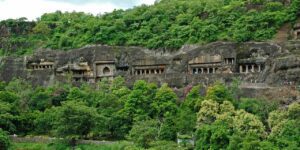Ajanta Caves, Maharashtra:World Heritage Sites In India
These caves date back to the 2nd century BCE and contain exquisite murals and sculptures that depict the life of Buddha and various stories from Buddhist scriptures,World Heritage Sites In India.


The Ajanta Caves, situated in Maharashtra, India, are a remarkable testament to the ancient Buddhist civilization’s artistic and religious achievements. Designated as a UNESCO World Heritage Sites In India these caves represent some of the finest examples of rock-cut architecture and Buddhist art in the world.
The Ajanta Caves consist of a complex of 30 rock-cut cave temples, carved into the horseshoe-shaped rock face of a cliff along the Waghora River. These caves were excavated over several centuries, with the earliest caves dating back to the 2nd century BCE and the latest to around the 6th century CE.
The caves at Ajanta can be categorized into two main phases:
- Early Hinayana Phase (Caves 9, 10, 12, 13, and 15A): These caves, dating from the 2nd century BCE to the 1st century CE, are among the earliest at Ajanta and were primarily used by Buddhist monks for meditation and religious rituals. They feature simple architectural designs and contain carved monastic cells, prayer halls, and stupas.
- Mahayana Phase (Caves 1-8, 11, 14, 15, 16-29): These caves, dating from the 5th to the 6th century CE, represent the zenith of Ajanta’s artistic and architectural achievements. They feature elaborately carved facades, intricately decorated interiors, and exquisite sculptures and murals depicting scenes from the life of the Buddha, Buddhist Jataka tales, and various deities and celestial beings.
The most iconic among the Ajanta Caves is Cave 1, also known as the “Cave of the Great Buddha.” This cave features a grand prayer hall with a massive seated statue of the Buddha in the teaching posture (Dharmachakra Mudra), surrounded by intricately carved pillars and sculptures.
The Ajanta Caves’ murals are particularly renowned for their beauty and artistic finesse. These ancient frescoes, painted with natural pigments, depict a wide range of subjects, including the life of the Buddha, scenes from Buddhist mythology, courtly life, and daily activities. The vivid colors, delicate brushwork, and expressive compositions of these murals continue to captivate visitors and art enthusiasts alike.
The Ajanta Caves remain an enduring symbol of India’s rich cultural and artistic heritage, attracting visitors from around the world who come to marvel at their architectural splendor and artistic treasures. They serve as a reminder of the profound impact of Buddhism on Indian civilization and the enduring legacy of ancient Indian art and architecture.World Heritage Sites In India
The Ajanta Caves are indeed one of the most renowned World Heritage Sites In India. Located in Maharashtra, India, these caves are famous for their exquisite rock-cut architecture and ancient Buddhist artworks. Here’s some key information about the Ajanta Caves:
- Location: The Ajanta Caves are situated in the Aurangabad district of Maharashtra, India. They are approximately 100 kilometers from the city of Aurangabad and around 400 kilometers from Mumbai.
- History: The caves date back to the 2nd century BCE and were actively used by Buddhist monks until the 7th century CE. They were carved out of a horseshoe-shaped cliff along the Waghora River. The caves served as monastic retreats, where Buddhist monks practiced meditation and lived.
- Architecture and Art: The Ajanta Caves consist of 29 rock-cut cave monuments, including chaitya halls (prayer halls) and viharas (monasteries). These caves are adorned with magnificent sculptures, paintings, and frescoes, depicting various aspects of Buddhist life, teachings, and stories from the Jataka tales.
- Significance: The Ajanta Caves are significant not only for their architectural and artistic brilliance but also for their historical and cultural importance. They provide valuable insights into ancient Buddhist civilization, art, and architecture in India.
- UNESCO World Heritage Site: The Ajanta Caves were designated as a UNESCO World Heritage Site in 1983, recognizing their universal value and importance for humanity. They attract visitors from all around the world who come to admire their beauty and learn about India’s rich cultural heritage.
- Preservation and Conservation: Efforts have been made over the years to preserve and protect the Ajanta Caves. Conservation measures include stabilizing the rock structures, protecting the paintings from environmental damage, and managing tourism to minimize the impact on the site.
- Visiting: The Ajanta Caves are open to visitors, and there are designated pathways to explore the various caves. Visitors can witness the intricate carvings, sculptures, and paintings that adorn the walls and ceilings of these ancient caves.
Overall, the Ajanta Caves stand as a testament to India’s rich cultural and artistic heritage, drawing in tourists, scholars, and art enthusiasts alike from across the globe.
: The Ajanta Caves were designated as a UNESCO World Heritage Site in 1983, recognizing their universal value and importance for humanity. They attract visitors from all around the world who come to admire their beauty and learn about India’s rich cultural heritage.
- Preservation and Conservation: Efforts have been made over the years to preserve and protect the Ajanta Caves. Conservation measures include stabilizing the rock structures, protecting the paintings from environmental damage, and managing tourism to minimize the impact on the site.
- Visiting: The Ajanta Caves are open to visitors, and there are designated pathways to explore the various caves. Visitors can witness the intricate carvings, sculptures, and paintings that adorn the walls and ceilings of these ancient caves.
Overall, the Ajanta Caves stand as a testament to India’s rich cultural and artistic heritage, drawing in tourists, scholars, and art enthusiasts alike from across the globe.
Also Read :-Sundarbans National Park-World Heritage Sites In India
